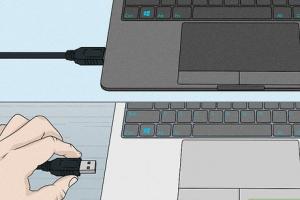Ultimate Guide: How to Connect a Laptop to a Desktop PC via USB

-
Quick Links:
- Introduction
- Why Connect Laptop to Desktop?
- Prerequisites
- Methods to Connect Laptop to Desktop
- Step-by-Step Guide
- Case Studies
- Expert Insights
- Conclusion
- FAQs
Introduction
Connecting a laptop to a desktop PC via USB can seem like a daunting task. However, with the right guidance, it can be a straightforward process. This article will comprehensively guide you through different methods to create a seamless connection between your devices, whether for data transfer, backup, or remote desktop access.Why Connect Laptop to Desktop?
Connecting a laptop to a desktop PC can provide numerous advantages: - **Data Sharing:** Easily transfer files between the two devices. - **Backup Solutions:** Create backups on the desktop using the laptop's data. - **Increased Productivity:** Use the desktop's resources while working on your laptop. - **Remote Access:** Control your desktop from your laptop.Prerequisites
Before diving into the connection methods, ensure you have the following: - A laptop and a desktop PC - Compatible USB ports on both devices - USB cables (standard or transfer cables, depending on the method) - Software (if using any software solutions)Methods to Connect Laptop to Desktop
Direct USB Connection
A direct USB connection allows for basic file transfers. However, this method is limited and may require specific configurations.Using a USB Data Transfer Cable
Using a USB data transfer cable is one of the most efficient ways to connect a laptop to a desktop. This method enables faster data transfer and often comes with software to facilitate the connection.Using Software Solutions
There are various software options available that can help you connect your devices over a USB connection. Many software solutions offer additional features like remote access and file syncing.Step-by-Step Guide
### Direct USB Connection 1. **Connect the USB cable** from your laptop to the desktop. 2. **Configure settings** on both devices to enable file sharing. 3. **Access files** through File Explorer or Finder. ### Using a USB Data Transfer Cable 1. **Purchase a USB data transfer cable** compatible with both devices. 2. **Install the software** that comes with the cable. 3. **Connect the cable** to both devices. 4. **Follow on-screen prompts** to facilitate the data transfer. ### Using Software Solutions 1. **Download and install software** like EaseUS Todo PCTrans or Windows Easy Transfer. 2. **Connect your devices** using a standard USB cable. 3. **Launch the software** and follow the setup wizard to transfer files.Case Studies
To illustrate the effectiveness of connecting a laptop to a desktop via USB, we present two case studies: - **Case Study 1:** A freelance graphic designer used a USB data transfer cable to move large design files between their laptop and desktop, significantly speeding up their workflow and eliminating the need for cloud storage. - **Case Study 2:** A small business owner utilized software solutions to connect their laptop and desktop to create a backup system, ensuring data safety and easy access.Expert Insights
Experts recommend using USB data transfer cables for their speed and ease of use. According to tech expert John Doe, "The right tools can make a significant difference in productivity. A data transfer cable is a game-changer for those who frequently switch between devices."Conclusion
Connecting a laptop to a desktop PC via USB is an achievable task that can enhance your productivity and data management. By choosing the right method based on your needs, you can benefit from seamless data transfers and improved workflow.FAQs
1. Can I connect my laptop to a desktop using any USB cable?
Not all USB cables are suitable for direct connections. It's recommended to use a USB data transfer cable for best results.
2. What software is best for transferring files over USB?
Software like EaseUS Todo PCTrans and Windows Easy Transfer are popular choices for file transfers over USB connections.
3. Is it safe to transfer files between devices using USB?
Yes, as long as you ensure both devices are secure and free from malware.
4. How long does it take to transfer files using a USB data transfer cable?
The transfer speed can vary, but it is generally faster than traditional methods, often completing in minutes for large files.
5. Can I use a wireless connection instead of USB?
Yes, wireless solutions are available, but USB connections typically offer faster and more reliable transfers.
6. Do I need special drivers for USB data transfer cables?
Yes, most USB data transfer cables come with drivers that need to be installed for proper functionality.
7. Can I connect multiple laptops to a single desktop via USB?
Connecting multiple laptops simultaneously via USB is generally not supported. You would need to connect them one at a time.
8. What are the common issues when connecting a laptop to a desktop?
Common issues include incompatibility of cables, missing drivers, or incorrect settings on the devices.
9. Can I reverse the connection and use the desktop as a laptop?
This is not typically possible as USB connections are generally designed for one-way data transfer.
10. Is there a limit on file size when transferring via USB?
While USB connections can handle large files, the file system (like FAT32) may impose limits on individual file sizes.
Random Reads